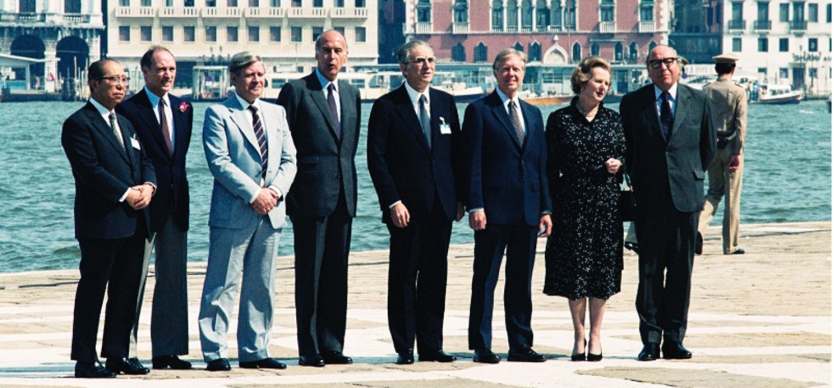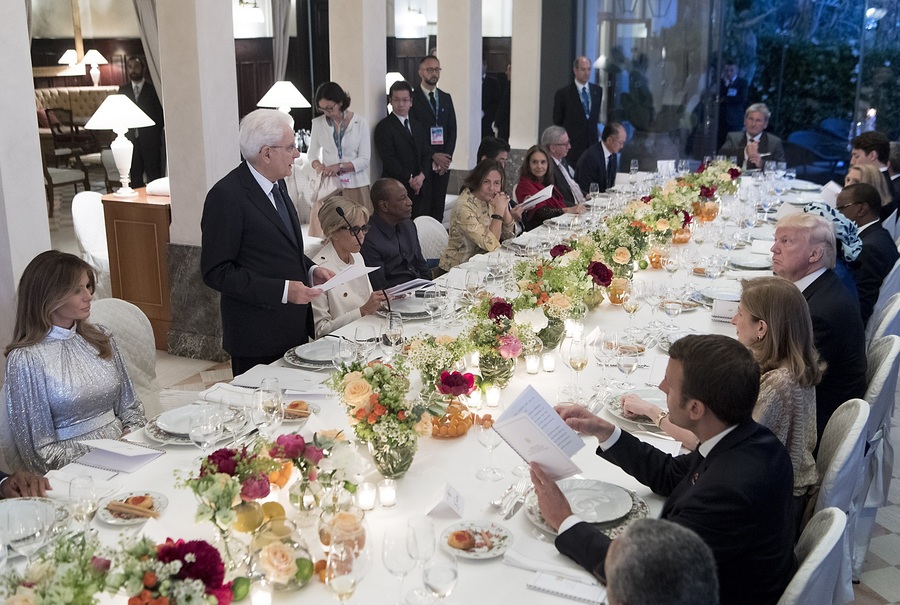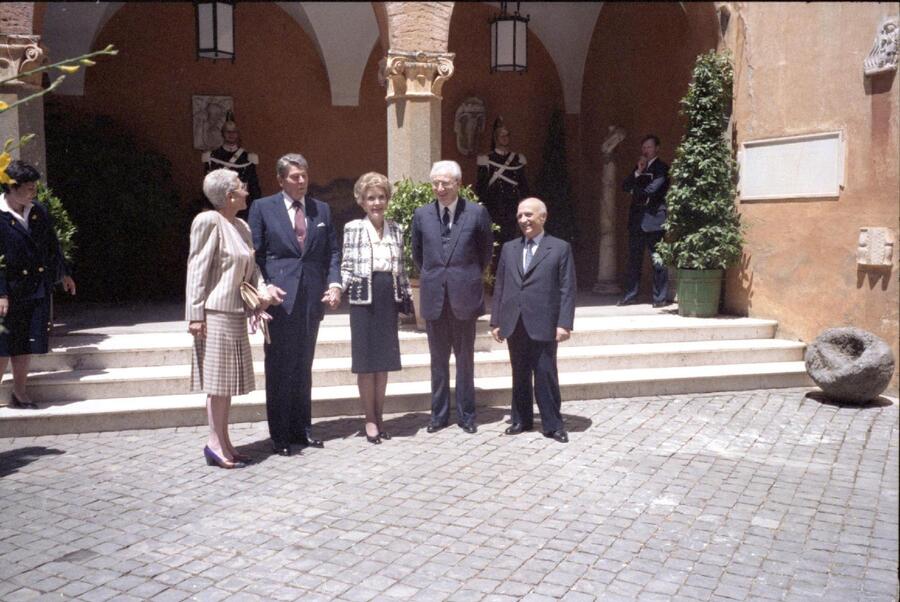Italy is preparing to host the G7 summit for the seventh time, bringing together the leaders of the most industrialized countries: Canada, France, Germany, Japan, Italy, the United Kingdom, and the United States.
The event, scheduled for 13 to 15 June in Borgo Egnazia, a luxury resort in Puglia, sees Italy as the main player in setting the agenda and drafting the final documents.
In 1980, Italy hosted its first G7 meeting in Venice, on the island of San Giorgio Maggiore, with Council President Francesco Cossiga at the helm.

The atmosphere on the eve of the summit was marked by the passing away of the Japanese prime minister.
During the proceedings, the United States firmly called for the condemnation of Iran for the kidnapping of American citizens at the embassy in Tehran.
The 1980 G7 was the first to address the issue of climate-damaging gas emissions, demonstrating an early awareness of environmental issues.
President Carter chose the Cipriani Hotel on Giudecca Island and surprised everyone, including protocol officials, by attending a dinner with his wife Rosalynn and daughter Amy at the Ancient Locanda Montin in Dorsoduro, while a summer storm threatened to flood the restaurant.
His presence at a mass celebrated with Catholic rituals in the Church of St. Euphemia, and his visit to the monastery of St. Giorgio Maggiore, where he shared milk, bread, and cheese with the 12 Benedictine monks, helped create a special bond between the President and the lagoon city.
In 1987, Venice once again hosted the G7 meeting, with Amintore Fanfani as head of a resigned government in anticipation of parliamentary elections.
To ensure efficient logistics and that participants remained close to the meeting place, cruise ships were chartered to the Cini Foundation. The reception, offered by President of the Republic Cossiga, took place in the Hall of the Greater Council of the Ducale Palace.
On that occasion, with a curious stratagem, Cossiga “convinced” Fanfani and Andreotti to follow him on foot, through the crowded Venetian streets, to the lunch venue, without escort and along a path that had not been previously controlled.
Ronald Reagan and the First Lady stayed in Villa Condulmer of Mogliano Veneto, experiencing curious details such as the opportunity for the President to ride at the adjacent horse riding facility.
The presidential suite was embellished with artworks, including an Annunciation from the 16th century and two stone chapels from the 15th century on either side of the bed.
During those days, Reagan made a brief visit to Rome for an audience with Pope John Paul II at the Vatican and a lunch with Cossiga in the park of Castelporziano.
The official visit, originally planned as more extensive, was reduced to a private meeting due to the upcoming Italian elections, creating a moment of embarrassment because Reagan’s desire to commemorate the 40th anniversary of the Marshall Plan with a public speech went unmet.
The 1994 G7 summit took place in Naples with Silvio Berlusconi, who had just taken office as Prime Minister. Mr. Ciampi had proposed the city as the summit’s location when he was head of government.
Among the iconic moments of that G7 is Clinton’s image, in front of a pizza place in the historic center, intent on enjoying a folded pizza.

Hillary Clinton and her daughter Chelsea, after visiting the Monastery of Santa Chiara, explored the Amalfi Coast, following in the footsteps of Jacqueline Kennedy and admiring the beauty of Positano, Amalfi, and Ravello.
The gala lunch took place in the Throne Room of the Royal Palace of Caserta, with President Scalfaro and his daughter Marianna welcoming the guests.
The images of the illuminated Royal Park, with leaders fascinated by Diana’s and Atteone’s evocative fountain, were seen around the world.
The American President experienced a moment of emotion standing in front of the picture of the young Sergeant William Blythe, photographed working in the Jeep depot of allied troops in the Reggia di Caserta. Upon returning to the US, Sergeant Blythe had died in a car accident; three months later, his son William was born, destined to become Bill Clinton, the 42nd President of the United States.
The 2001 G7 summit in Genoa, with Berlusconi as the head of the government, will be remembered as a summit marked by tragic and controversial events.
The days before the meeting were marked by growing concern over possible social disorder and violent actions.
About 200,000 people arrived in Genoa, some of whom took part in protests that escalated into violence.
At the end of the summit, a protester lost his life: Carlo Giuliani, shot by a carabiniere, while several hundred people were injured, sparking a long series of lawsuits and parliamentary investigations.
In the United States, Republican George W. Bush was the President, having beaten Democrat Al Gore in an election determined by a narrow difference of votes.
Bush arrived in Genoa after announcing that he would withdraw from the Kyoto Protocol, which he considered not to be in line with the country’s economic interests, but had already been signed by many of the participants in the summit.
The official lunch offered by President Ciampi was held in the Prefecture a few hours after the death of Carlo Giuliani, in an atmosphere full of drama and tension.
The 2008 G8, chaired for the third time by Berlusconi, took place in L’Aquila. Initially planned in La Maddalena, Sardinia, the summit was moved following the earthquake in Abruzzo, to demonstrate the solidarity of the participating countries with the communities affected by the tragedy.
The image of Barack Obama, in his shirt sleeves, next to Silvio Berlusconi in front of the ruins of the Prefecture’s palace became a symbol of the summit.

The summit was an important opportunity to raise awareness among world leaders about the urgent need for reconstruction, and it obtained promises of support for the restoration of damaged monuments.
Barack Obama, accompanied by his wife Michelle, met Napolitano at the Quirinale, thanking him for his leadership at such a challenging time for the country.
The 2017 G7 meeting in Taormina, Sicily, chaired by Prime Minister Gentiloni, will be remembered for the complexity of finding common positions.
Trade issues were one of the reasons for division, with Europeans in favor of multilateralism and free trade, while Donald Trump proposed barriers, tariffs, and protectionism.
In particular, the US President pointed out divergences that could no longer be disguised as diplomatic formulae, expressing dissatisfaction with the protocols of multilateral summits and deciding to avoid the traditional final press conference and instead address the US troops in Sigonella.
All eyes were on the two first ladies at their international debut: Brigitte Macron and Melania Trump, in a challenge of style, joined their husbands for a concert of the Philharmonic of La Scala in the beautiful Milan theater.

Trump later had a meeting with President Mattarella in Rome, followed by a second in Taormina at the official lunch in honor of the personalities present.
Although non-binding, these summits play a leading and guiding role; the concentration of power arouses great interest in public opinion and the media.












